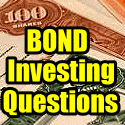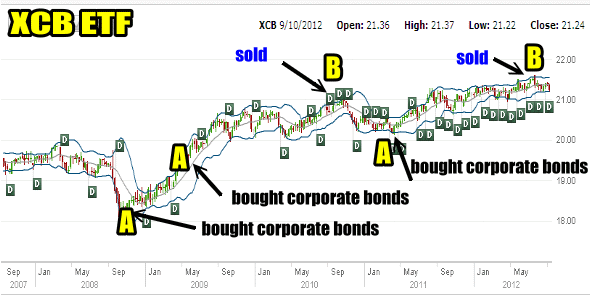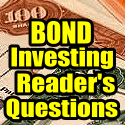 I get lots of questions every day and some are better answered on my site so I can refer other readers to them. This question came from Bill on my options forum who wanted more information about my bond holdings. While my website is designed for my stock holdings, I can understand his interest and I will try to answer as many of his questions as I can.
I get lots of questions every day and some are better answered on my site so I can refer other readers to them. This question came from Bill on my options forum who wanted more information about my bond holdings. While my website is designed for my stock holdings, I can understand his interest and I will try to answer as many of his questions as I can.
Bond Portfolio Reader’s Question
The best way to answer Bill’s questions is to answer each of his questions within his posting. Before answering his questions I want to mention that what Bill is referring to when discussing my overall strategy and my 30% bond allocation can be read through this link and this link if your scroll down to My Capital Breakdown.The amounts you see on the website are portions of my 40% in stocks. I do not show my bonds or cash portions as my website deals with stocks and Put Selling or other option trades, but I can understand his interest in my bond part of my overall portfolio.
30% In Laddered Bonds
To quickly outline, I keep 30% of my entire portfolio in laddered bonds. I then keep 30% in cash and like instruments and 40% is invested in stocks.
Here are his questions about the bond part of my portfolio and my answers to each question.
Hi Teddi: In reading your posts, on FullyInformed.com, I see that a 30% allocation to bonds is part of your strategy, which leads me to several questions:
1) Do you invest in individual bonds, or bond mutual funds?
I only invest in individual bonds. I have no interest in bond mutual funds. I tend to trade my bonds. I have found over decades of dealing with bonds that I get much better prices when I hold the bond itself rather than the bond fund. Bond funds also take a percentage and I am not interested in paying for something I can easily do myself. As well bond funds never mature. You don’t want to end up selling your bond ETF at a time when it has fallen in value. I prefer individual bonds and I buy everything from governments of all levels including municipal to utility to corporate to even school board bonds. I structure my bonds from 1 to 10 years. I have no bonds beyond 10 years. It is rare when I hold bonds to maturity. I almost always trade them, buying and selling them often in a contrary manner to what most are doing.
2) Do you use market timing when you purchase bonds?
I don’t use the same kind of market timing for purchasing or selling bonds as I do for stocks. Instead I use interest rates and in particular a variety of Bond ETFs to guide me when to buy and when to sell my bonds. For example in bear markets many investors flee stocks and run to bonds. I can get enormous returns by selling my bonds at that time, particularly 5 to 10 year bonds. Shorter term bonds can certainly jump in value but often the better move is in the 5 year range. In 2008 as markets collapsed I sold half my bond portfolio. By early 2009 for the first time I had only about 15% of my bonds left and they were all very short-term bonds.
To buy bonds I look for periods when the interest by other investors in owning bonds is dropping off. To assist me in “timing” when to buy bonds I use various ETFs. This article is not going to be long enough to explain how I trade in bonds. The bond market dwarfs stocks. It is huge in size and there are a variety of bonds available. There are different maturities, different types, etc. I would have to write a number of articles to cover off everything I know about bond investing. Here though is a good example.
In 2008 to 2009 when the stock market was falling apart, quality (I use the word loosely) A rated US and Canadian government bonds rose dramatically in value. That’s when I sell bonds. But not all bonds work the same. For example in 2008 to early 2009, everyone was dumping corporate bonds. So while I was busy selling A rated government bonds I was buying A and B rated corporate bonds. To follow the various bonds markets I used a variety of techniques in the past but today I use the ETFs. I don’t buy them, I use them to view what others are busy doing.
Below is a very simple example and should not be construed as a method for buying and selling bonds. I use it here to give you an idea as to how I buy and sell bonds. Below is the XCB ETF Bond Fund. This ETF is composed of Canadian Corporate Bonds with maturities no shorter than 1 year. You can see at point A when the bond fund had fallen. In the fall of 2008 as the “financial world” was expected to collapse, corporate bonds were being dropped everywhere. Values plummeted as seen in the drop at point A. I then began buying corporate Canadian bonds with maturities of 3 to 7 years. At point B in 2010, everyone figured that perhaps it had been a mistake and the financial world was not going to fall apart. Institutions were back buying corporate bonds. For one thing, many institutions need higher interest rates and since government bonds in Canada as well as the United States had low-interest rate yields, many institutions turned to A and B grade corporates. That’s when I started selling my corporate bonds.
In early 2011 I have marked another A point which is around the time when a lot of analysts began to think that interest rates might begin to rise again. They started selling corporate bonds as you can see in the XCB ETF. I was buying corporate bonds again. Point B just a couple of months ago is when I was back selling my corporate bonds once more as it had become clear to analysts that interest rates were going to stay at historic lows for an extended period of time. You can see at the end of the chart below that corporate bonds are again under pressure as many bond investors are wondering if interest rates might rise further particularly with Bernanke’s QE3, so they are selling some corporate bonds again.

I follow bond ETFs to pick times to buy and sell
The above chart is a simple example and only covers specific corporate bonds. The bond market is extremely large and none of the charts are the same. There are numerous types of corporate, state, provincial, municipal, utility bonds with a wide period of time for maturity. There are Treasuries and inflation protected Treasuries as well. Some are as long as 50 years, many are 30 and tons of bonds are in the 5 to 10 as well as short-term. With interest rates so low presently, many issues are in the 1 to 3 year range.
I hope the above helps. As I say I could write books on buying and selling bonds. It is a complex, high traded market.
3) How do you structure your bonds portfolio in terms of which bond sector you invest in, i.e. high yield (junk), investment quality, world bonds… and how about duration: short, intermediate or long-term?
I think most of that is answered above. I pick 1 to 10 year with most of my bonds in the 5 to 10 year range.
4) Do you advocate an all in approach, dollar cost averaging, or an opportunistic approach in terms of when conditions are right?
I think from the above information you can see that I use an opportunistic approach in terms of when conditions suits my style of buying. I tend to buy when most are selling and sell when most are buying. I don’t really do dollar cost averaging. I normally pick the bonds I want, follow them and wait for the conditions to appear that I want. I then begin buying them. Remember stocks are not bonds. You get a better price for bonds when you have a larger quantity. When buying bonds I try to buy at least $25,000 to $50,000 in value of a single bond. I get a better buy price and a better sell price.
5) Do you ever stray away from your 30% allocation to bonds?
Not really. Sometimes I have sold so many bonds that I no longer have 30% invested in bonds, but my bond portfolio holds the same percentage of the entire portfolio. Therefore as I make more capital in my stock part or my bond part, I rebalance the entire portfolio so that 30% is in bonds, 30% in cash and 40% in stocks.
Any advice regarding bonds would be appreciated.
It is an incredible market and bonds are as exciting as stocks. But there are many differences and varied tools to use when trading either of them. Many people look at bonds as being safer than stocks. I guess because they get their original investment returned to them so they appear safer. I know that if I was hold a government bond for 30 years and earning 2.5% and had bought it for a premium price I don’t think I would be very happy about it. Buying bonds when yields are incredibly low and holding them to maturity I think is asking for actual or real losses in capital.
I believe that bonds need to be traded to earn above average returns. Parking money for even 10 years earning 2 or 3 percent is not a way to grow capital in my opinion. The bond markets are huge in comparison to stocks. There are just so many different types of bonds that perhaps it would be best to concentrate on a few types and build a portfolio and strategies from there. I have spent 3 decades plus with bonds and I learn something new about them every day.
My only caution would be listening to analysts and even bond fund managers. Instead I would be watching what the better bond fund managers are doing. Pimco has a good track record among bond fund managers and yet I recently read Bill Gross is telling investor to buy dividend paying stocks. I find this puzzling as Gross is not great at stocks. Bonds are his forte. So you can see that figuring out who to follow is difficult. I cannot tell you who to learn from or who to follow. My bond strategies works for me but it certainly isn’t for everyone. Thank you for your question.

